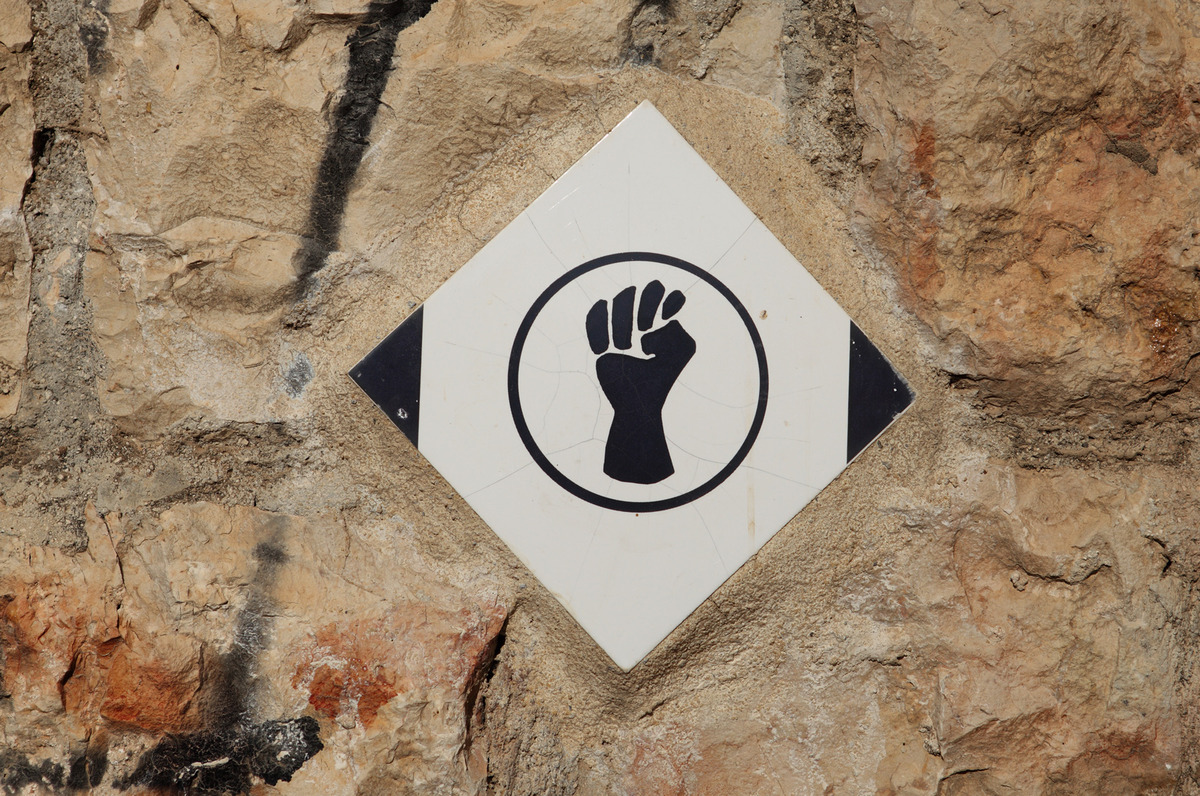הא לחמה עני – Ha Lachma Anya
“This is the bread of affliction that we ate in Morocco and Egypt
And we did not know that we wouldn’t even have this in Jerusalem. In Morocco, all who are hungry could come and eat.
In Jerusalem all this was forgotten.
In Morocco they promised us that we will be free.
But it turns out that they forced us into slavery.”
– Excerpt from Israeli Black Panthers Passover Haggadah, 1971
Israeli civil society today faces an unprecedented conflict between both the Israeli state and its population, as well as the settler Zionist movement and indigenous Palestinians. July alone saw thousands of Israelis marching from Tel Aviv to the Knesset in Jerusalem, increased settler and military violence in the West Bank, and an official judicial overhaul that sought to deregulate Israel’s judiciary.
At this moment of heightened conflict, we must remember, and draw inspiration from the Mizrahi Black Panther Party’s legacy of intersectional activism in Israel. This summer, I spoke with Asaf Elia-Shalev, a Mizrahi staff reporter for the Jewish Telegraphic Agency and author of a forthcoming book on the Israeli Black Panther party.
Elia-Shalev explained that while the current democracy protests in Israel are largely made up of “Tel Aviv liberals,” it’s important to remember that there has always been a Mizrahi Left in Israel. The Israeli Black Panther Party was founded in 1971 by Moroccan Jewish youth leaders – including Sa’adia Marciano and Charlie Biton – to fight for racial justice and human rights in Israel and Palestine.
To understand the plight of the Mizrahi Black Panthers and what they can teach us, one must go back in time to the very founding of Israel.
“Civilized” vs. “Barbaric”
The creation of the state of Israel spurred the formation of a new “Mizrahi” identity. “Mizrahi” translates to “eastern”, or perhaps more accurately, “oriental,” as outlined by Edward Said’s infamous book Orientalism. This new descriptor applied to all Jews from Morocco to Iran, both east and west of Israel.
Theodor Herzl, in his book Der Judenstaat, planned for Israel to be “an outpost of civilization as opposed to barbarism,” assigning the label of “civilized” to Israelis, and denoting Arabs, Palestinians, and non-Europeans as “barbaric.” Za’ev Jabotinsky, an early Zionist leader, also proclaimed, “We Jews have nothing in common with what is called the Orient, thank God.” In 1996, Ehud Barak, Israel’s tenth Prime Minister called Israel a “a modern and prosperous villa in the middle of the jungle.”
Since the founding of Israel, Zionist ideology has always distinguished between the intended inhabitants of the Jewish colony – white Jews mostly from Europe – and those who were excluded from those rights, namely Mizrahi immigrants, Palestinians, and Arab Jews.
In this fantasy, the settler population would bring civilization and modernity to a population that was – supposedly – desperate to be modernized. But the “barbarism” which Herzl names ignores centuries of advanced technology, community culture and development, and stable working economic systems of the Middle East and Palestine.
From the development of the State of Israel through the 1980s, Mizrahi Jews experienced a “mass exodus” away from their Middle Eastern home countries to Israel. They were promised better lives of financial and socio-economic growth. Instead, up to 250,000 Middle Eastern Jews were placed in internment camps called ma’abarot where they faced “acute overcrowding, poor sanitation and limited water and electricity, and unbearably difficult weather conditions,” according to the National Library of Israel. Mizrahi communities were expected to leave their Middle Eastern homelands to “volatile front-line borders and empty desert expanses, on the basis that their supposed naturally “primitive state” could withstand living in such harsh conditions without modern comforts and standards.” Meanwhile, Ashkenazi immigrants were placed mostly in displaced Palestinians’ homes.
Despite the attempt to white-wash Israel, the Middle Eastern state has a majority ethnically Middle Eastern population. Between Palestinians and Mizrahi Jews, the modern state of Israel contains mostly Middle Easterners, many of them being Arab Jews.
The Black Panthers’ Legacy
The Israeli Black Panthers advocated for economic and social rights for Mizrahim within Israel, and human rights for Palestinians. The Panthers’ pursuit for justice arose out of decades of discrimination against Mizrahim. As Elia-Shalev explains, “they brought attention to the violence of poverty, and of denying someone an education.”
The result of the Panthers’ work was the expansion of socio-economic rights for Mizrahim in Israel. According to Elia-Shalev, “The year after the Panthers got started was the first time in Israeli history that spending on social welfare issues exceeded spending on the military and security.”
Through their protests, the Panthers demanded a newfound commitment to political, economic, and social rights for Mizrahi communities. “In proudly espousing Mizrahi identity, the Panthers revolutionized Israeli society,” said Elia-Shalev. “They put the Mizrahi issue, and domestic and equality issues front and center in the Israeli public’s mind – and until the Panthers showed up, they were almost always on the sideline.”
The Mizrahi Black Panthers were inspired by the wider Black Panther Party, and quickly aligned themselves with decolonial leaders across the globe. They met with Danny the Red, connected with young South American Jewish radicals, participated in the Global Socialist Conference in 1973, and joined a week-long, student and youth-led protest in East Berlin.
“They were connected to the global, transnational activism,” Elia-Shalev said.
A Shift in Consciousness
While the Panthers catalyzed policy changes, they also brought about a significant shift in consciousness. “A whole generation of Mizrahi artists and scholars became empowered to create art,” Elia-Shalev explained. “You had a flourishing in literature, dance, music, really any realm of cultural creation after the Panthers in the 70s and 80s.” This change in consciousness reflects the pivotal works of race theorists Frantz Fanon and Ella Shohat on ethnic identity.
Mizrahi Studies academic Ella Shohat elaborates on the fraught identity politics of Mizrahim in Israel. Shohat explains that the “Within Zionist ideology, the very term “Arab Jew” is an oxymoron and a misnomer, a conceptual impossibility… Arab Jews were urged to see Judaism and Zionism as synonyms, and Jewishness and Arabness as antonyms. Thus Arab Jews were prodded to choose between anti-Zionist Arabness and a pro-Zionist Jewishness.”
But the Mizrahi Black Panthers broke through this dichotomy, and advocated for Palestinian rights to be preserved, aligning themselves with the PLO. Elia-Shalev explained that the Panthers “wanted to envision an Israeli state that was inclusive, that treated all of its citizens well, and that made peace with the Palestinians.”
Generations of a state ideology have demonized the existence of the “Arab other” in a context where the majority of the population is Middle Eastern – either Palestinian or Mizrahi. Ethnic discrimination toward Mizrahim and ethnic violence toward Palestinians are two sides of the same coin; they are both white supremacy.
The imposition of Arab and Jew as antonyms has led to a rupture of identity and belonging for Jews of Color, socially, linguistically, and culturally forced out of their brownness, all the while still residing in a predominantly non-white country in the Middle East. Shohat teaches that “Mizrahim in Israel were made to feel ashamed of their dark, olive skin, of their guttural language, of the winding quarter tones of their music, even of their traditions of hospitality.”
Frantz Fanon’s monumental work “Black Skin, White Masks” explores self-facing racism in the context of the colonial French social world. Fanon reflects on how a non-white person can gain social capital by reducing his difference in an assimilationist world: “He becomes whiter as he renounces his blackness, his jungle.” Shohat explicitly reflects on Fanon’s concept of self-hating white supremacy, explaining:
“At times Mizrahim were mistaken for Palestinians and arrested or beaten. Since Arabness led only to rejection, many Mizrahim became self-hating… Indeed, if it is true, as Malcolm X said, that the white man’s worst crime was to make the black man hate himself, then Mizrahi internalized self-hatred means that the Establishment in Israel has much to answer for. (In fact, Arab-hatred when it occurs among Mizrahim is almost always a disguised form of self-hatred.)”
The divide-and-conquer strategy, a story which has played out so unfortunately so many times in a variety of colonial “experiments,” forces neighbors against one another, tricked into distorting their neighbor as their enemy, all the while ignoring their common oppressor who uses the same violent force against them at once.
Daring to Dream
At this moment with the right to even deem Israeli violence unjust moves to be legislated as anti-semitic, the right of the Jewish community to govern its own state is called seriously into question. Even further, the degradation of natural rights and denial of the right to life of the inhabitants of allegedly the holiest place on earth calls into question the ethics we stand for as Jewish global citizens and members of the interreligious collective world.
As the veil of colonial erasure is lifted and communities address their fraught histories, the violence that has caused us to hate our neighbor will force us to choose between our worship of God and our worship of a political leader.
The Torah scholar Maimonides – who lived in the Muslim world – advises the Jews to stay vigilant when trusting political leaders or states to represent ethical purity or divinity. In his chapter “Foreign Worship and Customs of the Nations” in the Mishneh Torah, Maimonides teaches that one might mistake a political power with God, cautioning us against letting our hearts “lead us astray.”
Instead of worshiping these false political gods, I dare to dream of our community aspiring to its values of justice, equity, community, and inclusivity.
I dare to dream of an interreligious Middle Eastern identity.
I dare to dream of a Mizrahi self-perception that circumvents the European gaze and its fantasy of our home, identity, and culture.
I dare to dream of a world where my Judaism, my God, is not spewed as bullets or army raids or hate speech or settler marches on communities of our own Middle Eastern brothers and sisters.
Through the revolutionary tradition which I was taught is the core of Judaism, I dare to dream of a Middle Eastern community that can foster diverse, interreligious solidarity and justice both in and outside of Israel.
Image credit: zeevveez to Flickr

